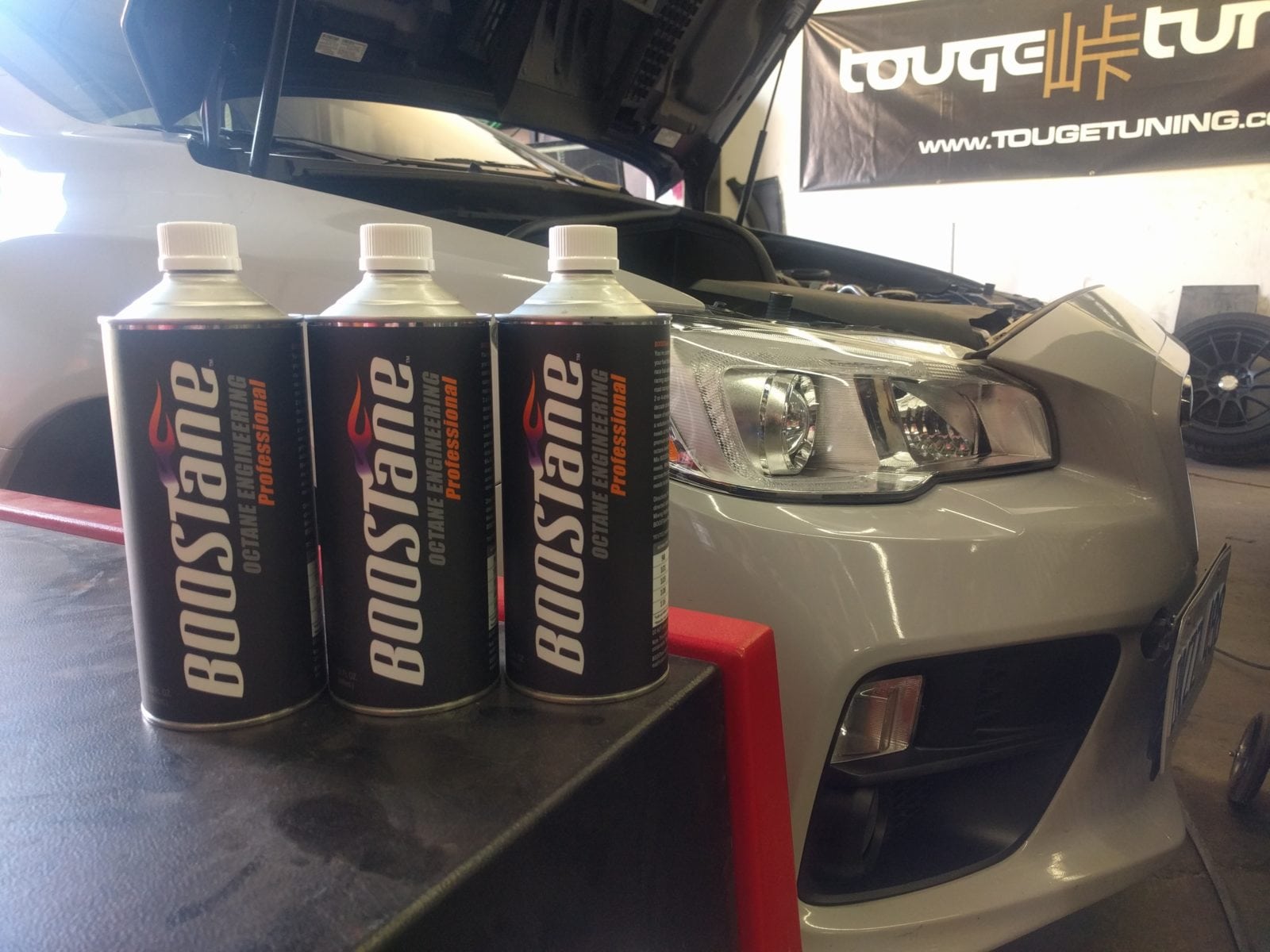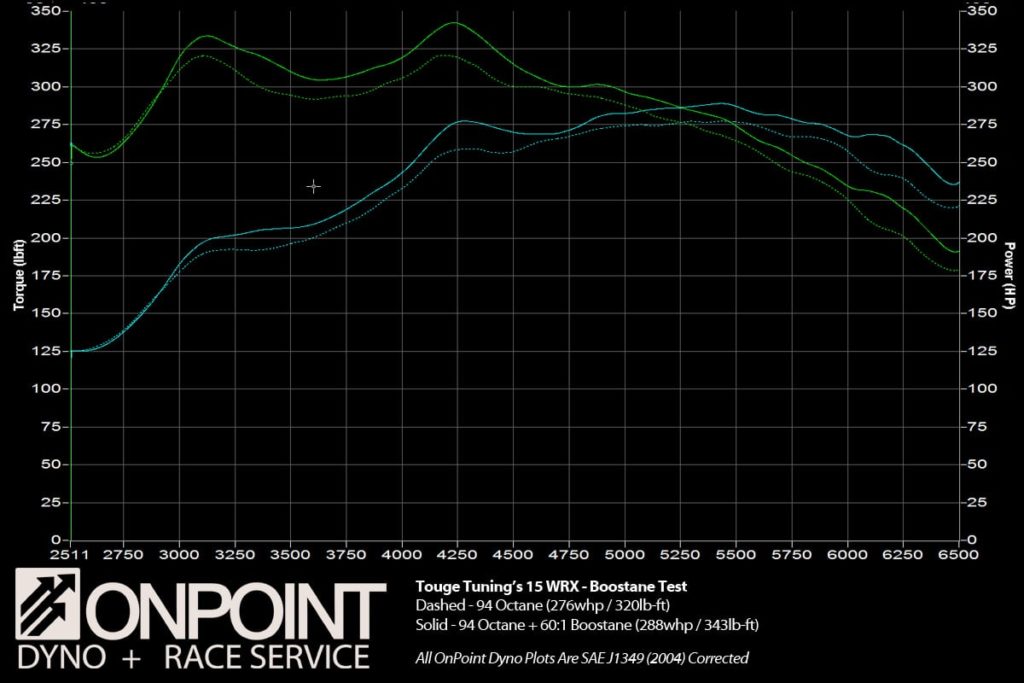Over the years of working in the performance industry, I’ve seen many new products advertised to make big power gains for a low cost with some sort of new “technology” or “additive”. As a car enthusiast, I have always been skeptical of these types of claims and because of this, I have avoided offering them as a product for sale through Touge Tuning. In recent years, however, I have seen cases of these products being tested by others with dyno charts to prove power gains can be had. Being somewhat skeptical of other peoples information I decided that we had to do our own testing at the shop to see if this stuff can really work as claimed. The product we chose to test was BOOSTane Pro which is advertised to be able to convert fuel from 93 octane to as high as 116 octane. These are lofty claims to back up so we contacted BOOSTane prior to our testing to see if they would provide us samples to test. To my surprise, they would not provide samples of their product for our testing because they were confident that their product would yield positive results. The reason I mention this is so that everyone reading this understands that we paid for the product out of pocket and this isn’t an article that is biased because we were given the product for free.
So we ordered up a 5 Gallon pail of the BOOSTane Professional product and asked our partner in tuning (Sasha of OnPoint Dyno) to come by and do some testing with us on the product. Prior to doing this Sasha had tested a similar product on a few cars including Kels his 350Z race car. The car we’d use for testing is my personal DD and Track Vehicle, Project Northstar, which is a lightly modified 2015 Subaru WRX. We chose to use this car as we had a lot of previous dyno data on the car and it still has the stock turbo like the majority of those likely reading this article. This is important as the potential for gains is typically greater with a larger turbo and this can skew the results. With the stock turbo and current modifications we know the engine is knock limited so if we can increase the octane rating we should be able to make more power in theory. For the test, we decided to start with the gas tank filled to the brim with roughly 60 Liters of Petro Canada 94 Octane. This is what the car has always run and been tuned on multiple times. We would then start by adding 1 quart of BOOSTane to the 60L of 94 Octane, which would give us a 60:1 ratio and according to Boostane would get us to around 102 octane rating. We would tune the car until it would reach the point of knocking and dial it back slightly like we would do for most cars. We’d then add another can (1 quart) and repeat the process. We chose to stop at 3 cans as we felt this is the most product a typical enthusiast would use on their car in one shot and is equal to the cost of purchasing a 20L pail of VP’s MS109 Race Gas or similar product.
With the car loaded on the dyno we began with a baseline on the standard 94 Octane tune performing minor adjustments to ensure it was not knocking. As we’ve seen multiple times in the past the car made around 275-280WHP at the threshold of knock which can be seen very accurately with the available data from the new WRX’s ECU which is faster than older models and it also has 2 knock sensors vs. the single knock sensor of the EJ series. To be exact the car produced 276WHP and 320lb-ft on 94 octane alone. We did a couple runs and took the median so the numbers aren’t inflated. Next, we added the first quart of BOOSTane Professional and let it mix in with the 94 Octane. Sasha then proceeded to tune the mixture to the limit as mentioned previously. Initially, he added 2 degrees of ignition timing and the car made more power and had 0 signs of knock. This was pretty impressive considering the car was previously on the verge of knock on just 94 octane and we now had 2 degrees more timing with ZERO signs of knock. He then added another degree of timing and the car made even more power and we started to see small amounts of noise from the knock sensor so we felt this was a safe place to stop. So with a single can of Bboostane on 60L of fuel we could have a safety margin of 3 degrees of ignition timing over the 94 tune or make 12WHP and 23WTQ more bringing us to 288WHP and 343WTQ.
Next, we put in another Quart of BOOSTane and again let it mix through the fuel system. This would put us at a 30:1 ratio of BOOSTane to 94 Octane pump fuel, bringing us to around 103-104 octane rating. Sasha went back to work and tuned the car to the same point. Again he was able to add more ignition timing and make even more power. final numbers for this ended up at 303WHP and 330lb-ft which is an increase of 27 horsepower compared to where we started the day on pump 94 octane.
At this time we were pretty impressed with the power gains and we weren’t sure more power could be extracted beyond this. But we went another round, as we planned, and added another Quart of the product to the fuel system and mixed it in. At this point we were sitting at a 20:1 ratio which should put us at around 105 octane. Sasha worked his magic again and after a few runs we maxed out the power on our current set-up. He added more timing and around 1lb more boost to the tune before encountering the early signs of knock. Final numbers for safety ended up at 312WHP and 341lb-ft which leaves us with a gain of 36HP at a rough cost of $120 for the 3 cans of BOOSTane Pro. We did push the car right to the limit on the 20:1 ratio and we were able to squeak out 316WHP however this would leave no room for error and as such, we rolled it back to 312WHP.
So what does all of this information mean to you? How is this relevant? We view this as a product that can be used in a few different ways, to provide additional safety and/or make more power. The first use we see is for adding a nice buffer of safety for those attending track days or HPDE days. Using a single 1 Quart can of BOOSTane pro to a typical 50-60L fuel tank you can safely have a 3 degree buffer of ignition timing. What this means is that you can safely run your car hard on track without the worry of knock/detonation as the engine starts to get really hot. No custom tuning is needed with BOOSTane as it is not oxygenated so it’s as simple as putting it in the tank and driving. The other way this product can be used is to have the car tuned at a specific mixing ratio, like we did in this test, and use it to make more power like you would race gas. If we pre-mix 20L jerry cans with 1 can of BOOSTane Pro we could run our 2015 WRX with an additional 36HP for a cost of roughly $60 per 20L or $3 per litre. This is about half the cost of a pure race gas product such as VP MS109. We have tested race gas before and the power figures are almost identical with the BOOSTane actually making slightly more power than a previous test we did with 110 Octane race fuel.
After completing our testing we went ahead and became an authorized dealer for BOOSTane product and we have it in stock at the shop in both 1 Quart and 5 Gallon Pails. We have used it in multiple instances with clients and friends at the track and have not had any issues with the product. Everyone has come back and purchased more of it for every track outing as not having to watch you feedback knock at the track for $40 is great peace of mind. Check out this link if you’d like to find out pricing or place an order for it, https://tougeold.wpengine.com/brand/boostane/






Sam Leung
I have a 2018 BRZ and the BC Chevron Gas (94 rating) is known to be bad. Am I correct that I don’t need any tuning if I add one can of Professional (32 oz) with a full tank of gas? It should be safe to do so? Thanks!
“No custom tuning is needed with BOOSTane as it is not oxygenated so it’s as simple as putting it in the tank and driving”
ChrisTouge
No tuning is required with Boostane because it is not oxygenated so it does not affect the Air/Fuel Ratio at all.
Chad
Nothing better than a dyno to prove results! thanks for the awesome data!
Eric Hahn
They claim to raise octane 23 points. Now, this is a math teaser because people are confused by this – 23 points is only 2.3 octane increase. So on 94 octane they claim it’ll make 96.3 octane.